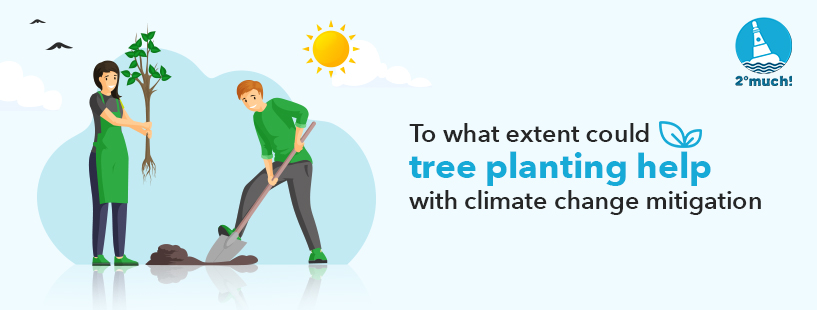Just think of it: Plant a tree to stop climate change. There’s almost a poetic touch to the notion. Human beings redeeming and saving themselves by giving back to nature. However, is it really viable? Is it backed by science? Before we get excited about planting a new tree, let’s first sit back and look at what the research says about its effects on climate change mitigation.

What the Science Says About Tree Planting for Reducing the Impact of Climate Change
You probably know by now that carbon dioxide is the main culprit behind accelerated climate change. And you’re probably also well aware that trees “absorb” carbon to produce oxygen. Essentially, trees do this to fulfill their metabolic processes, which, in turn, allow them to produce oxygen.
Based on studies, the rate and level of CO2 absorption (or carbon sequestration in more scientific terms) vary. Usually, it’s affected by factors like:
- The specific species of the tree
- Local conditions and slopes
- Climate factors like temperature and average rainfall
- Age of the tree – Older trees tend to store more carbon in their roots and trunks, besides the soil near them.
However, that’s obviously just a glimpse of the way trees are able to reduce the build-up of the said gas in the atmosphere. If we’re going to dive deeper into how it works, we’ll need to get a little technical.
Basically, when you plant your own tree, there will come a time when its biomass will increase as it slowly grows. It will require more carbon to maintain its structural components like hemicellulose, cellulose, and lignin. It metabolizes the carbon through photosynthesis.
This is why if you want to know the amount of carbon dioxide removed by any tree, the most important parameter to pay attention to is the weight of its biomass. Nearly half of the said weight is composed of carbon.
Once it reaches 25 years, experts agree that it’s easier to calculate the exact quantity removed by the tree — and, more often than not, it’s a lot! Of course, this would still depend on the species.
What Species Should You Plant Then?
With all species considered, it’s actually oak that’s been found to be most carbon-absorbing. The horse-chestnut comes to a close second. It’s no wonder tree planting in the USA prioritizes these species. But obviously, these trees don’t grow in all regions of the world.
For a more general criterion, you want to be considering trees with the broadest leaves possible. The larger the leaves, the greater the photosynthesis. It really won’t hurt to focus on prioritizing efficiency, given the limited timetable we have before irreversible effects occur.
Certain characteristics of the trees should also be considered when, for instance, you’re planning to buy a tree for someone or donate a tree as a gift in general. You want to be able to provide the best possible help, right? So, take the time to think of these other essential factors before making your decision:
- Quick-growing trees tend to exhibit the most carbon sequestration during the first few decades of their lives.
- Native species will thrive better in your locality and can offer the best opportunities for wildlife to grow.
- Low-maintenance trees that can resist most diseases and require minimal to zero insecticides and chemical fertilizers should be prioritized. This is because they can do without these things that only add to the earth’s problems, such as greenhouse gas.
- Young trees in the tropics tend to sequester carbon more quickly than in other regions.
Regarding The Green Belt Movement
As far as historical proof goes, there’s no better success story than the one started by Professor Wangari Maathai through Kenya’s Green Belt Movement. It’s worth a mention since it’s one of the first (it’s been around since 1977) major tree-planting initiatives that are still ongoing. If you ever encounter the term, “gift a tree”, chances are, the movement is behind it.
It goes without saying that we at Climate Compensation see the Green Belt Movement as our primary inspiration in launching our own initiative. On the whole, it’s worth commending their continued efforts, which have practically gone uninterrupted over the years.
The fact that most of their tree planting activities at present are centered on mitigating climate change only serves to underline the sheer importance of tree planting programs worldwide.
Other Issues Need to be Tackled
Sadly, while the effect of planting trees for the environment is already considerably significant, it’s being held back by other negative factors and issues. More or less, we can’t ignore the problems posed by:
- The lingering effects of the industrial revolution
- Profit-oriented capitalism
- Deforestation
- Unplanned urbanization
More than one of these issues directly contributes to continued carbon emission. It’s safe to say that as long as problems remain unsolved, the efforts of tree planting groups will not be able to achieve the best, possible results. Just imagine the immense positive effects that can be brought about by a single tree planting event if these problems are virtually non-existent.
Underscoring the Immensity of the Challenge
It’s also important to underscore the fact that planting billions of hectares of trees is an endeavor that’s easier said than done. It’s an undertaking that will require the dedication of the best tree planting organizations and, if possible, the entire human race.
In fact, scientists actually recommend reforesting a landmass that is the equivalent of the size of the United States. Do you know how long it will take for that to be made possible? 1,000 to 2,000 years! On the whole, it takes time for new forests to exert any significant change in the amount of carbon in the atmosphere. However, when all is said and done, every tree counts!
Conclusion
What’s obvious from the facts outlined above is that forest tree planting or any other endeavor related to growing the number of trees worldwide is a step in the right direction. It may not be enough as it is to stop climate change completely. However, it’s arguably still a vital step. We owe it to advocates in the past to finish what they started and make their initial goals come to fruition.

